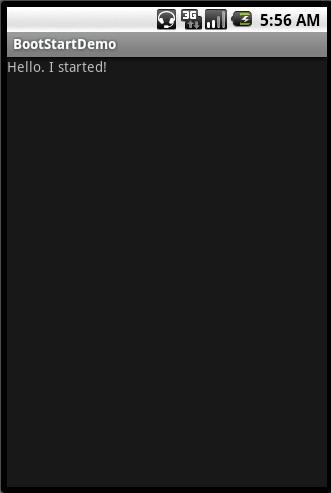編輯:Android開發實例
有時我們需要應用在Android設備開機時自動運行,就像Windows系統中的很多程序一樣。比如說有些後台service需要從網絡上更新內容等等。那麼如何讓應用在開機時自動運行呢?本文給出一個實例進行詳細說明。
該實例要實現的功能是,在Android手機開機後,自動運行實例程序,在屏幕上顯示文字“Hello. I started!”。
背景知識:當Android啟動時,會發出一個系統廣播,內容為ACTION_BOOT_COMPLETED,它的字符串常量表示為android.intent.action.BOOT_COMPLETED。只要在程序中“捕捉”到這個消息,再啟動之即可。記住,高煥堂先生對Android框架的總結:Don't call me, I'll call you back。我們要做的是做好接收這個消息的准備,而實現的手段就是實現一個BroadcastReceiver。
Android程序開機自動運行的實例代碼解析:
1、界面Activity:SayHello.java
Java代碼這段代碼很簡單,當Activity啟動時,創建一個TextView,用它顯示"Hello. I started!"字樣。
2、接收廣播消息:BootBroadcastReceiver.java
Java代碼該類派生自BroadcastReceiver,覆載方法onReceive中,檢測接收到的Intent是否符合BOOT_COMPLETED,如果符合,則啟動SayHello那個Activity。
3、配置文件:AndroidManifest.xml
XML/HTML代碼注意其中粗體字那一部分,該節點向系統注冊了一個receiver,子節點intent-filter表示接收android.intent.action.BOOT_COMPLETED消息。不要忘記配置android.permission.RECEIVE_BOOT_COMPLETED權限。
完成後,編譯出apk包,安裝到模擬器或手機中。關機,重新開機。
運行截圖:

延伸思考:在多數情況下,要自動運行的不是有界面的程序,而是在後台運行的service。此時,就要用startService來啟動相應的service了。
 Android應用程序簽名步驟及相關知識介紹
Android應用程序簽名步驟及相關知識介紹
本文主要講解Android應用程序簽名相關的理論知識,包括:什麼是簽名、為什麼要給應用程序簽名、如何給應用程序簽名等。 1、什麼是簽名? &
 Android MediaPlayer(多媒體播放)
Android MediaPlayer(多媒體播放)
Android提供了許多方法來控制播放的音頻/視頻文件和流。其中該方法是通過一類稱為MediaPlayer。Android是提供MediaPlayer類訪問內置的媒體播放
 Android JSON解析器
Android JSON解析器
JSON代表JavaScript對象符號。它是一個獨立的數據交換格式,是XML的最佳替代品。本章介紹了如何解析JSON文件,並從中提取所需的信息。Android提供了四個
 Android本地化
Android本地化
Android應用程序可以在許多不同地區的許多設備上運行。為了使應用程序更具交互性,應用程序應該處理以適合應用程序將要使用的語言環境方面的文字,數字,文件等。在本章中,我